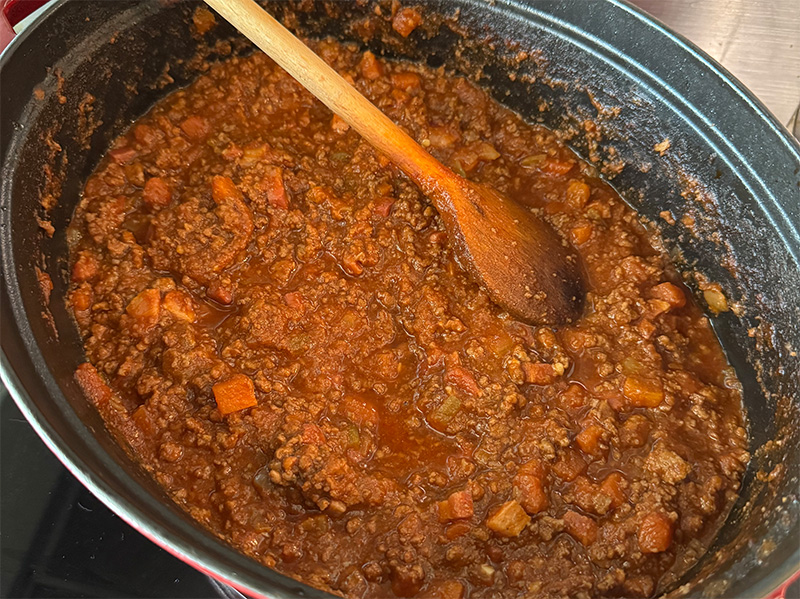“I’m also just a girl, standing in front of a boy, asking him to love her.”
– Anna Scott (Julia Roberts), Notting Hill (1999)
I’m a sucker for romcoms. That moment in Notting Hill? Devastating. And what a fumble from Anna Scott. Hear me out: grand romantic gestures have nothing on a really good meal and a glass of wine. While she went for a dramatic plea, I’d argue a simple and delicious slow-simmered Ragù alla bolognese would’ve sealed the deal faster. I wholeheartedly, unequivocally, and passionately believe that food can spark love. And if not love, anecdotal evidence suggests it at least can spark one of its more entertaining by-products where fewer clothes also means more dessert. Or maybe it’s the French in me.
Still, the French aren’t the only ones who see food this way. Italians also share the same view: food and love are at the heart of both cultures, which is why they complement each other so well. It’s also probably why Paris and Rome, two cities of equal passion, share an exclusive sister city-bond since 1956 whose motto is, in the language of Dante Alighieri: “Solo Parigi è degna di Roma, solo Roma è degna di Parigi”. It means “Only Paris is worthy of Rome; only Rome is worthy of Paris”. I’ve always thought that hits hard.
Now, sure, Dante himself never tasted a proper Ragù alla bolognese, let alone cooked one, as the dish only evolved in the 18th century, shaped with a touch of French culinary influence. After all, the Italian word ragù comes from the French ragoût. The dish that we know and love was only recorded recently at the Accademia Italiana Della Cucina in 1982, and a revised version was published in 2023.
With that in mind, today, we’ll attempt to one-up Dante and cook a proper Ragù alla Bolognese. This is the recipe and quantities that I use. I usually cook multiple batches and give most of it to neighbors and friends. I then keep whatever’s left in the freezer. My recipe slightly deviates from the official one. Mine blends that with the recipe found in the book The Silver Spoon (Il cucchiaio d’argento). That being said, the Accademia allows for my variation… Except for my use of garlic which it forbids. But honestly, is a life without garlic even worth living? I’ll let you be the judge and decide whether you want to use garlic or not.
Now, to the food.
Recipe
Ingredients
Serving: 8 persons, ~1.6kg (~3½lbs) of Ragù al bolognese
- 600g (1.3lbs) ground beef
- 300g (10.6oz) pancetta
- 2 onions
- 2 carrots
- 2 celery ribs
- 24cl (1 cup) of wine (white or red. I usually use white.)
- 400g (14 oz) passata di pomodoro (tomato purée)
- 2 tablespoons of double concentrated tomato paste
- 50-75cl vegetable broth, adjust quantity while simmering. I use Maggi Kub Or.
- 30g (2½ tbsp) of butter
- 2 tablespoons of olive oil
- Salt and pepper
- Optional: 3 cloves of garlic
Equipment
- Cast iron Dutch oven (ideal)
- Wooden spoon
- Knives
- Cutting board
- Optional: Garlic press
How to
Dice the onions, pancetta, carrots, and celery into macédoine (6mm / ¼-inch cubes). Don’t forget to remove the stringy bits from the celery. If you don’t know what I mean, see this video on How To Cut Celery on Jamie Oliver’s YouTube channel. Keep everything separate, though you can combine the carrots and celery.
Add butter and olive oil in the pan. Now, full disclosure: it happens that I use more than the quantities shared, it’s mood-dependent. Set the heat on medium, cover, and sweat the onions for 10 mins, stirring regularly to prevent browning.
Add the carrots and celery in the pan. Keep covered and stir regularly until they begin to soften and lose their crunch.
Uncover, raise the heat, and add the pressed (or minced) garlic at the bottom of the pan. Let it toast for 1 minute. Then add the ground beef and pancetta, breaking up the ground beef with your spoon as it cooks. Stir until the meat is evenly browned and it sizzles.
Pour in the wine. Stir occasionally and let it fully evaporate. Then add the passata and tomato paste, and pour enough broth to cover the meat and vegetables, stirring as you go.
Reduce the heat to low. Cover and let gently simmer for (at least) 1 hour and 30 minutes. Uncover every 30 minutes, stir to prevent sticking, and top up with broth if needed to keep everything covered. You could let it simmer longer if you want – for instance, 2 or 3 hours. The more it simmers, the more the flavours blend.
Finally, remove the lid, and let the sauce reduce to the desired consistency while stirring occasionally. It can take 30 minutes or more.
Adjust the seasoning to your liking with salt and pepper.
Pasta and serving
What pasta to use? The French often go for spaghetti, but that’s heresy. It just doesn’t do the sauce justice: it can’t hold it properly. And that’s the thing: you need pasta that hold the sauce. If you insist, no one’s stopping you, but consider these alternatives. Traditionalists should go for tagliatelle, the canonical pairing used in Emilia-Romagna. If you want to nod to tradition while going your own way, try garganelli (a ridged tube-like pasta), or even gramigna, more commonly paired with sausage-based ragùs. If tradition isn’t your concern and you’re feeling decadent, go for fusilli. Its spirals catch the sauce so well, each bite feels sinful.
Serve with grated parmesan (Parmigiano Reggiano), someone you like, and no plans for the evening. And let me know how that goes.
